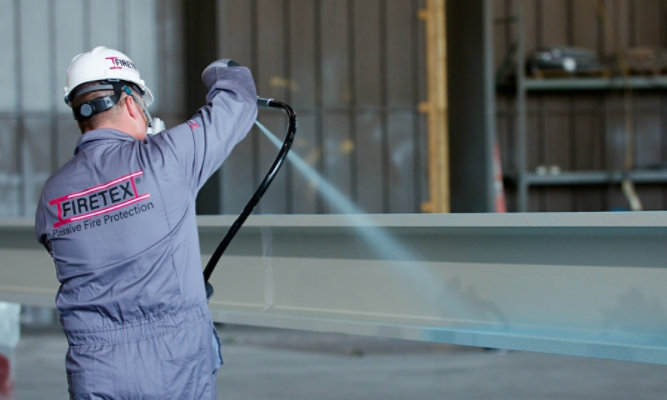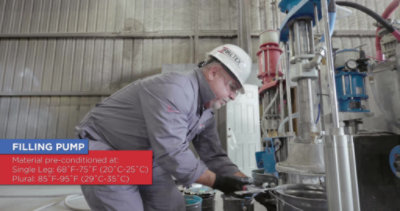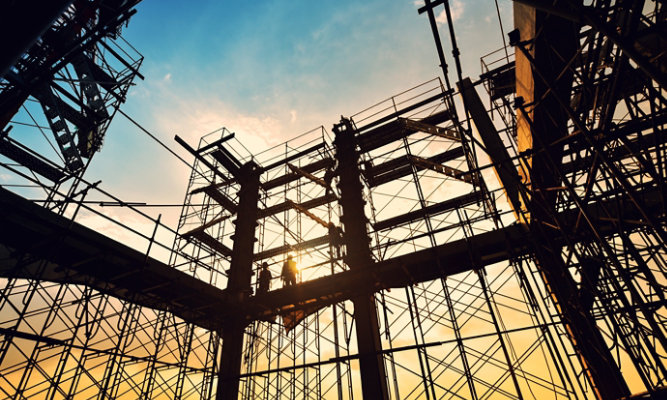Sustainable Building Practices Catch Fire: How Intumescent Fireproofing Contributes to Sustainability
Accreditation Programs, Software and Intumescent Coatings Help Optimize Sustainable Designs
by Carl Burrell, Global Product Director - Fire, and Max Tritremmel, Global Fire Protection Market Segment Director, Sherwin-Williams Protective & Marine
This article originally appeared in Market Pulse: Advancements in Coatings Technology, Vol. 2.

Considering Intumescent Coating Options to Develop a Sustainable Building
Developing a sustainable building requires a holistic approach that minimizes the total environmental impact of the systems, materials and maintenance required to construct, operate and preserve the building over its design life. Even seemingly minor decisions can have major sustainability implications.
That includes intumescent coatings, as their chemistry, application requirements and durability can all play a significant role in a building’s total environmental impact — and its accreditation. For many building owners, sustainability considerations begin and end with programs such as LEED (Leadership in Energy and Environmental Design) and BREEAM (Building Research Establishment’s Environmental Assessment Method). Such programs evaluate a building’s environmental impact, right down to the intumescent coatings applied to structural steel. Buildings can earn points based on the materials of construction used, with wise product selections earning precious credits and supporting high sustainability ratings.
The sustainability of a building related to its fire protection method can vary greatly, especially because the structure’s design determines how much intumescent coatings to use. Thicker steel may have a higher environmental footprint than thinner steel, but it requires less fire protection. Therefore, architects will need to consider whether thicker steel and less applied coatings is a more sustainable combination than thinner steel with more applied coatings. Balancing these factors — along with the lifetime environmental impact of the coatings — will help them design a structure that achieves the desired level of sustainability, while also tracking costs. Using software tools and enlisting help from a coatings manufacturer can help them determine that balance.
A focus on sustainability also involves applicators, who face the direct environmental impacts of mixing, heating and spraying coatings. For them, sustainably sound coatings with low rates of volatile organic compound (VOC) emissions, reduced application thicknesses and fast drying times can help reduce environmental impacts.
Comparing Intumescent Coatings’ Sustainability Potential
Coatings can contribute certification credits in three LEED categories and two BREEAM categories. The programs set baseline documentation and data standards for comparing building materials. However, it’s difficult to make direct intumescent coating sustainability comparisons due to reporting discrepancies.
Manufacturers can provide an Environmental Product Declaration (EPD) for all LEED- and BREEAM-qualifying intumescent coatings. EPDs are meant to quantify every input and output required to manufacture a product, use it and then dispose of it at the end of its life — a complete Life Cycle Analysis (LCA) estimating its lifetime carbon output. That includes everything from the raw materials used to produce the product, the total carbon emissions during its manufacture and use, and how it’s disposed.
Not all EPDs are equal, however, and two differences are especially important when comparing coating sustainability. First, BREEAM requires third-party validation of EPDs to the ISO 14025 standard, while LEED accepts EPDs submitted by manufacturers, adding a 1.5x multiplier for those with third-party validation. Second, the LCA methods used in product EPDs often differ. The most complete LCAs use a “cradle to grave” approach, encompassing all carbon outputs for the life of a coating through the end of a building’s life (typically set at 60 years). However, some manufacturers use shorter “cradle to gate” or “gate to gate” LCAs, which measure less of a product’s carbon emissions impact.
Given these disparities, making apples to apples comparisons of intumescent coatings’ sustainability potential is difficult.
Leveraging Software to Drive Better Designs and Enhance Sustainability
Architects and engineers should work directly with their coatings manufacturer to review options for enhancing sustainability. That includes examining how design adjustments may affect a building’s environmental footprint. As an example, the Sherwin-Williams Fire Engineering and Estimation Team (FEET) can help teams determine the appropriate coating dry film thickness (DFT) needed for any structural steel member to meet a desired fire protection rating, while also considering the environmental impact of that application compared to a different building design.
A critical evaluation tool is the FIRETEX® Design Estimator (FDE), a software package that plugs into business information modeling (BIM) systems and enables architects and engineers to integrate and evolve fire protection considerations during the design process. They can adjust the sustainability of fireproofing methods in relation to the entire structure. That includes calculating the application’s CO2 equivalent (kg CO2 e/kg of product) — the expression of the product’s carbon emissions in terms of its Global Warming Potential (GWP) over an estimated 60- year building design life. The FDE tool can calculate the CO2 equivalent for the full amount of fireproofing protection required in real time, allowing operators to optimize designs for sustainability and budget.
Enhancing Sustainability with Shop-Applied Intumescent Coatings
Where and how coatings are applied, whether in the field or in a fabricator shop, also has sustainability implications. Shop applications offer several potential advantages, not only in terms of sustainability, but often in terms of fireproofing quality and cost. For example, field-applied fireproofing performed in busy cities introduces the potential release of VOCs in populated areas. Controlled shops include environmental and abatement systems to reduce the atmospheric release of VOCs. In addition, field applications face longer application times, more challenging surface preparation and less uniform applications due to their less controlled environment.
Enhancing Sustainability with Intumescent Coating Selections
In either the shop or field, intumescent coating selections contribute directly to a structure’s environmental footprint. Using coatings with low VOCs, low application thicknesses and fast drying times can enhance sustainability. That may include a variety of water-, solvent-, or epoxy-based coatings, including thinner-film ones that support the growing use of Architecturally Exposed Structural Steel(AESS). This approach showcases steel in a building while eliminating the costs and environmental impacts of covering the steel in layers of drywall, cladding and coatings.
Among the variety of intumescent coatings to consider, specifiers are best served by selecting ones with third-party verified EPDs to meet BREEAM requirements and maximize LEED credits. It’s also helpful if the EPDs are based on full “cradle to grave” LCAs that quantify the products’ full carbon equivalents over their life cycles. Further qualifications may consider initial application costs, the number of applied coats, maintenance needs and the coating’s longevity.
For example, a water-based intumescent coating such as FIRETEX FX5090 is low VOC and has a low initial carbon equivalence; yet, it must be maintained over time, potentially requiring repair or reapplications, which add to carbon emission totals. An epoxy-based intumescent coating, like FIRETEX FX9502, may have a higher initial carbon equivalence. However, its greater durability means less maintenance, and lower in-service costs. Finally, ultra-high solids coatings like FIRETEX FX6002 combine the low-VOC and high-durability elements of epoxies, while introducing ultra-fast drying properties — with as little as 45 minutes handling time. This enables rapid shop throughput for coated steel, with minimized handling damage and without accruing high heating costs and emissions.
Hope for a Sustainable Future with the Help of Intumescent Coatings
With the seemingly small choice of an intumescent coating having such an outsized effect on a building’s sustainability potential, optimized designs are critical. Given today’s advanced coatings and robust modeling software, they’re well within reach.
Design and Develop a Sustainable Building with Intumescent Coatings from Sherwin-Williams
At Sherwin-Williams, we are committed to protecting steel structures and providing life-saving protection from fires. Our line of proven intumescent fireproof coating systems has been designed to deliver superior fire protection that meets the highest industry standards.
To learn more about our intumescent fire protective coatings and how these coatings can contribute to enhanced sustainability, contact a Sherwin-Williams representative today.
ABOUT THE AUTHORS
Carl Burrell is Global Product Director – Fire. With 23 years’ industry experience, Burrell has global responsibility for the Sherwin-Williams passive fire protection and cryogenic spill protection portfolio. He is a nominated BSI (The British Standards Institution) national expert on the International Organization for Standardization (ISO) TC67 and TC92 committees. Contact: Carl.Burrell@sherwin.com
Max Tritremmel is Fire Protection Market Segment Director – Americas for Sherwin-Williams Protective & Marine. For more than 26 years, he has served the coatings industry as a sales representative, business leader, industrial painting contractor and now marketer. He is an SSPC Protective Coatings Specialist and an SSPC Level 3 Certified Coatings Inspector. Contact: Max.Tritremmel@sherwin.com
Discover More
Industry Expertise and Innovation
See how we help customers find customized solutions for their project and application challenges.
Our Fire Protection Expertise
Explore our industry solutions and technology to help protect your assets.
LEARN MOREProduct Lookup
Find out more about our innovative coatings for a variety of industries.
FIND A PRODUCT

